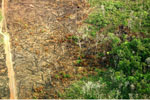The Amazon rainforest is facing a higher risk of fires this dry season, warns a fire prediction system developed by researchers using NASA and NOAA data.
The model is based on an observed correlation between sea surface temperatures in the tropical Atlantic and rainfall in the Amazon. High Atlantic temperatures tend to suppress precipitation in the Amazon by driving moisture into the Gulf of Mexico. The result is increased incidence of fire across the southern parts of Earth’s largest rainforest.
This year warmer-than-average temperatures in the tropical north Atlantic Ocean suggest an above-average risk for fires this summer and early fall. The Brazilian states of Mato Grosso, Pará, Rondônia and Acre as well as the Bolivan departments of Santa Cruz and Pando are particularly vulnerable.

Dials indicate regions in the southern Amazon forest predicted to have below-average fire activity (green) and above-average activity (orange and red) during the 2013 dry season, relative to the 2001-2012 mean. Credit: UC Irvine
The model correctly forecast a less active fire season in 2012 when Atlantic temperatures were cooler and Amazon rainfall was higher.
The model’s developers, led by Jim Randerson of the University of California at Irvine, are now refining the system to predict flooding. Unusually dry years seem to increasingly alternate with unusually wet years, leading to a drought/fire and flood cycle.
“With this forecasting system we’re hoping to build some advanced warning about whether the Amazon region is facing a fire year or a flood year,” said NASA’s Doug Morton is who works with Randerson’s team on the forecasts. “This year, plan for fires.”
Rainforest trees in the Amazon aren’t well adapted to fire, so even small fires can have a significant impact on forest structure and health. Other research has shown that small surface fires, which burn under the forest canopy, can kill up to 40 percent of trees. The associated die-off can leave the forest drier and more vulnerable to future fires. A study published in April by NASA’s Morton and colleagues indicates that up to 3 percent of the Amazon rainforest was affected by such fires between 1999 and 2010.
CITATION: D. C. Morton, Y. Le Page, R. DeFries, G. J. Collatz and G. C. Hurtt. Understorey fire frequency and the fate of burned forests in southern Amazonia. Philosophical Transactions of the Royal Society B June 2013 vol. 368 no. 1619 20120163. Published 22 April 2013 doi: 10.1098/rstb.2012.0163
Related articles
NASA: 3% of Amazon rainforest burned between 1999-2010
(06/08/2013) 33,000 square miles (85,500 square kilometers) or 2.8 percent of the Amazon rainforest burned between 1999-2010 finds new NASA-led research that measured the extent of fires that smolder under the forest canopy.
Amazon’s flood/drought cycle becoming more extreme, less predictable

(05/14/2013) The Amazon River’s hydrological cycle has become more extreme over the past two decades with increasing seasonal precipitation across much of the basin despite drier conditions in the southern parts of Earth’s largest rainforest, finds a new study published in Geophysical Research Letters. The research analyzed monthly Amazon River discharge at Óbidos, a point that drains 77 percent of the Amazon Basin, and compared it with regional precipitation patterns.
Researchers launch tool that predicts Amazon deforestation a year before it happens
(03/30/2012) Researchers have developed a methodology for accurately predicting where deforestation will occur in the Amazon up to a year in advance, enabling law enforcement agencies and officials to take preventative action before trees are actually chopped down, a forestry expert told mongabay.com on the sidelines of the Skoll World Forum for Social Entrepreneurship.
Frequent understory fires change rainforest community composition
(04/24/2013) Frequent understory fires change the composition of rainforest plant communities, potentially altering the capacity of forests to regenerate, finds a study published in special issue of the journal Philosophical Transactions of the Royal Society B.
>
Featured video: stemming human-caused fires in the Amazon
(04/09/2013) A new series of 5 films highlights how people use fire in the Amazon rainforest and how such practices can be mitigated. Collectively dubbed “Slash & Burn” each film explores a different aspect of fire-use in the Amazon. In recent years the Amazon has faced unprecedented droughts, possibly linked to climate change and vast deforestation, making the issue of human-started fires even more important.
Amazon rainforest failing to recover after droughts
(12/24/2012) The impact of a major drought in the Amazon rainforest in 2005 persisted far longer than previously believed, raising questions about the world’s largest tropical forest to cope with the expected impacts of climate change, reports a new study published in the journal Proceedings of the National Academy of Sciences.
Fire risk to increase in the Amazon rainforest
(06/20/2012) The risk of fire could increase across large parts of the Amazon rainforest due to increasing incident of drought, expansion of road networks, and rural outmigration, said a scientist speaking at the annual meeting of the Association for Tropical Biology and Conservation (ATBC) in Bonito, Brazil.
Repeated burning undercuts Amazon rainforest recovery
(09/26/2011) The Amazon rainforest can recover from logging, but has a far more difficult time returning after repeated burning, reports a new study in mongabay.com’s open-access journal Tropical Conservation Science. In areas where the Amazon had been turned to pasture and was subject to repeated burning, Visima trees become the dominant tree inhibiting the return of a biodiverse forest. The key to the sudden domination of Visima trees, according to the study, is that these species re-sprout readily following fires; a capacity most other Amazonian trees lack.
As Amazon deforestation rates fall, fires increase

(06/03/2010) While rates of forest loss in the Brazilian Amazon have been on the decline since 2004, the incidence of fire is increasing in the region, undermining some of the carbon emissions savings of reduced deforestation rates, report researchers writing in the journal Science. The paper argues that REDD, a global plan to reduce deforestation and forest degradation, must include measures to eliminate the use of fire from land management in the Amazon.
Smoke from Amazon fires reduces local rainfall
(08/14/2008) Smoke released by fires set to clear the Amazon rainforest inhibit the formation of clouds, thereby reducing rainfall, report researchers writing in the journal Science. The study provides clues on how aerosols from human activity influence cloud cover and ultimately affect climate.
Small fires a big threat to Amazon rainforest biodiversity
(02/27/2008) Small fires have a big impact in the Amazon rainforest, report researchers writing in Philosophical Transactions of the Royal Society B. The findings suggest a dire future for Earth’s largest rainforest.
Fire policy is key to reducing the impact of drought on the Amazon
(02/19/2008) Gaining control over the setting of fires for land-clearing in the Amazon is key to reducing deforestation and the impact of severe drought on the region’s forests, write researchers in a paper published in Philosophical Transactions of the Royal Society B.
Subtle threats could ruin the Amazon rainforest

(11/07/2007) While the mention of Amazon destruction usually conjures up images of vast stretches of felled and burned rainforest trees, cattle ranches, and vast soybean farms, some of the biggest threats to the Amazon rainforest are barely perceptible from above. Selective logging — which opens up the forest canopy and allows winds and sunlight to dry leaf litter on the forest floor — and 6-inch high “surface” fires are turning parts of the Amazon into a tinderbox, putting the world’s largest rainforest at risk of ever-more severe forest fires. At the same time, market-driven hunting is impoverishing some areas of seed dispersers and predators, making it more difficult for forests to recover. Climate change — an its forecast impacts on the Amazon basin — further looms large over the horizon.














